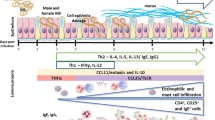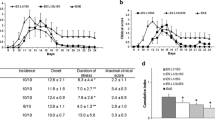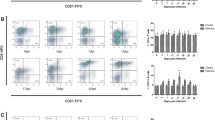Summary
Trichinella spiralis infection induces a host cell-mediated and humoral response. The role of T and B lymphocytes in the immune response of mice reinfected with 2 × 400 T. spiralis larvae was studied in relation to the parasite burden. BALB/c mice were infected on days 0 and 60 and immunological parameters were examined within a period of 180 days. In comparison with a single T. spiralis infection, T- and B-lymphocytes in reinfected mice responded by a significant increase in the proliferative activity during 10 days after reinfection. At the same time, the percentages of CD4+ T-cells of reinfected mice were also increased. In contrast, the CD8+ T-cell numbers were significantly reduced almost 30 days after reinfection. High concentration of serum IFN-γ lasted till the end of the experiment. The IL-5 level was increased only for 2 weeks after reinfection, followed by its decrease. Kinetics of specific anti-Trichinella immunoglobulins IgG2a was not affected with reinfection, but specific antibodies IgG1 significantly increased after reinfection and persisted elevated till the end of the experiment. Lower numbers of adults (69.2 % reduction) in the small intestine and 72.3 % reduction in muscle larvae were found after reinfection. Stimulation of the host immune response — the increased activity of CD4+ T lymphocytes and high levels of IFN-γ and specific IgG1 after reinfection, contributed to the reduction of the parasite burden.
Similar content being viewed by others
References
Anthony, R. M., Urban, J. F. Jr., Alem, F., Hamed, H. A., Rozo, C. T., Boucher, J. L., Van Rooijen, N., Gause, W. C. (2006): Memory T(H)2 cells induce alternatively activated macrophages to mediate protection against nematode parasites. Nat. Med., 12(8): 955–960. DOI: 10.1038/nm1415
Behnke, J. M, Mugambi, J. M., Clifford, S., Iraqi, F. A., Baker, r. L., Gibson, J. P., Wakelin. D. (2006): Genetic variation in resistance to repeated infections with Heligmosomoides polygyrus bakeri, in inbred mouse strains selected for the mouse genome project. Parasite Immunol., 28(3): 85–94. DOI: 10.1111/j.1365-3024.2005.00810.x
Beiting, D. P., Bliss, S. K., Schlafer, D. H., Roberts, V. L., Appleton, J. A. (2004): Interleukin-10 limits local and body cavity inflammation during infection with musclestage Trichinella spiralis. Infect. Immun., 72(6): 3129–3137. DOI: 10.1128/IAI.72.6.3129-3137.2004
Bell, R. G. (1998): The generation and expression of immunity to Trichinella spiralis in laboratory rodents. Adv. Parasitol., 41: 149–217. DOI: 10.1016/S0065-308X(08)60424-8
Bruschi, F., Chiumiento, L. (2011): Trichinella inflammatory myopathy: host or parasite strategy? Parasites Vectors, 4: 42. DOI: 10.1186/1756-3305-4-42
Despommier, D. D. (1993): Trichinella spiralis and the concept of niche. J. Parasitol., 79(4): 472–482. DOI: 10.2307/3283370
Despommier, D. D. (1998) How does Trichinella spiralis make itself at home? Parasitol. Today, 14(8): 318–323. DOI: 10.1016/S0169-4758(98)01287-3
Doligalska, M. (2000): Immune response to Trichinella spiralis larvae after treatment with the anti-allergic compound ketotifen. Parasitol. Res., 86(3): 232–238. DOI: 10.1007/s004360050036
Dvorožňáková, E., Kołodziej-Sobocińska, M., Hurníková, Z. (2005): Development of T-cell immune response in experimental murine trichinellosis. Helminthologia, 42(4): 187–196. DOI: 10.2478/s11687-010-0023-x
Dvorožňáková, E., Hurníková, Z., Kołodziej-Sobociń-ska, M. (2010): Kinetics of specific humoral immune response of mice infected with low doses of Trichinella spiralis, T. britovi, and T. pseudospiralis larvae. Helminthologia, 47(3): 152–157. DOI: 10.2478/s11687-010-0023-x
Dvorožňáková, E., Hurníková, Z., Kołodziejsobocińska, M. (2011): Development of cellular immune response of mice to infection with low doses of Trichinella spiralis, T. britovi, and T. pseudospiralis larvae. Parasitol. Res., 108(1): 169–176. DOI: 10.1007/s00436-010-2049-x
Else, K. J., Finkelman, F. D. (1998): Intestinal nematode parasites, cytokines and effector mechanisms. Int. J. Parasitol., 28(8): 1145–1158. DOI: 10.1016/S0020-7519(98)00087-3
Fabre, V., Beiting, D. P., Bliss, S. K., Gebreselassie, N. G., Gagliardo, L. F., Lee, N. A., Lee, J. J., Appleton, J. A. (2009): Eosinophil deficiency compromises parasite survival in chronic mematode infection. J. Immunol., 182(3): 1577–1583
Finkelman, F. D., Sheadonohue, T., Goldhill, J., Sullivan, C. A., Morris, S. C., Madden, K. B., Gause, W. C., Urban, J. F. (1997): Cytokine regulation of host defense against parasitic gastrointestinal nematodes: Lessons from studies with rodent models. Ann. Rev. Immunol., 15: 505–533. DOI: 10.1146/annurev.immunol.15.1.505
Grove, D. I., Hamburger, J., Warren, K. S. (1977): Kinetics of immunological responses, resistance to reinfection, and pathological reactions to infection with Trichinella spiralis. J. Infect. Dis., 136(4): 562–570.
Gu, Y., Li, J., Zhu, X. P., Yang, J., Li, Q., Liu, Z. Y., Yu, S., Li, Y. H. (2008): Trichinella spiralis: Characterization of phage-displayed specific epitopes and their protective immunity in BALB/c mice. Exp. Parasitol., 118(1): 66–74. DOI: 10.1016/j.exppara.2007.06.014
Gurish, M. F., Bryce, P. J., Tao, H., Kisselgof, A. B., Thornton, E. M., Miller, H. R., Friend, D. S., Oettgen, H. C. (2004): IgE enhances parasite clearance and regulates mast cell responses in mice infected with Trichinella spiralis. J. Immunol., 172(2): 1139–1145
Helmby, H., Grencis, R. K. (2003): IFN-gamma-independent effects of IL-12 during intestinal nematode infection. J. Immunol., 171(7): 3691–3696
Herndon, F. J., Kayes, S. G. (1992): Depletion of eosinophils by anti-IL-5 monoclonal antibody treatment of mice infected with Trichinella spiralis does not alter parasite burden or immunologic resistance to reinfection. J. Immunol., 149(11): 3642–3647
Ishikawa, N., Wakelin, D., Mahida, Y. R. (1997): Role of T helper 2 cells in intestinal goblet cell hyperplasia in mice infected with Trichinella spiralis. Gastroenterology, 113(2): 542–549. DOI: 10.1053/gast.1997.v113.pm9247474
Kang, S. A., Cho, M. K., Park, M. K., Kim, D. H., Hong, Y. C., Lee, Y. S., Cha, H. J., Ock, M. S., Yu, H. S. (2012): Alteration of helper T-cell related cytokine production in splenocytes during Trichinella spiralis infection. Vet. Parasitol., 186(3–4): 319–327 DOI: 10.1016/j.vetpar.2011.12.002
Kapel, C. M. O., Gamble, H. R. (2000): Infectivity, persistence, and antibody response to domestic and sylvatic Trichinella spp. in experimentally infected pigs. Int. J. Paraitol., 30(2): 215–221. DOI: 10.1016/S0020-7519(99)00202-7
Khan, W. I., Collins, S. M. (2004): Immune-mediated alteration in gut physiology and its role in host defence in nematode infection. Parasite Immunol., 26(8–9): 319–326. DOI: 10.1111/j.0141-9838.2004.00715.x
Kinashi, T., Harada, N., Severinson, E., Tanabe, T., Sideras, P., Konishi, M., Azuma, C., Tominaga, A., Bergstedt-Lindqvist, S., Takahashi, M., Matsuda, F., Yaoita, Y., Takatsu, K., Honjo, T. (1986): Cloning of complementary DNA encoding T-cell replacing factor and identity with B-cell growth factor II. Nature, 324(6092): 70–73. DOI: 10.1038/324070a0
Kołodziej-Sobocińska, M; Dvorožňáková, E; Dziemian, E. (2006): Trichinella spiralis: Macrophage activity and antibody response in chronic murine infection. Exp. Parasitol., 112(1): 52–62. DOI: 10.1016/j.exppara.2005.09.004
Kołodziej-Sobocińska, M; Dvorožňáková, E; Dziemian, E., Machnicka-rowinska, B. (2007): Trichinella spiralis reinfection: macrophage activity in BALB/c mice. Parasitol. Res., 101(3): 629–637. DOI: 10.1007/s00436-007-0527-6
Li, C. K. F., Ko, R. C. (2001): The detection and occurrence of circulating antigens of Trichinella spiralis during worm development. Parasitol. Res., 87(2): 155–162. DOI: 10.1007/PL00008569
Maclean, J. D., Viallet, J., Law, C., Staudt, M. 1989): Trichinosis in the Canadian Arctic: report of 5 outbreaks and a new clinical syndrome. J. Infect. Dis., 160(3): 513–520
Machnicka, B., Dziemian, E. (2001): Reduction of muscle larvae burden in rats experimentally infected with Trichinella spiralis. Parasite, 8(2): S223–S225
Mahida, Y. R. (2003): Host-parasite interactions in rodent nematode infections. J. Helminthol., 77(2): 125–131. DOI: 10.1079/JOH2003172
Moloney, A., Denham, D. A. (1979): Effects of immune serum and cells on newborn larvae of Trichinella spiralis. Parasite Immunol., 1(1): 3–12. DOI: 10.1111/j.1365-3024.1979.tb00691.x
Morales, M. A. G., Mele, R., Sanchez, M., Sacchini D., Degiacomo, M., Pozio, E. (2002): Increased CD8(+)-Tcell expression and a type 2 cytokine pattern during the muscular phase of Trichinella infection in humans. Infect. Immun., 70(1): 233–239
Moskwa, B. (1999): Trichinella spiralis: in vitro cytotoxicity of peritoneal cells against synchronous newborn larvae of different age. Parasitol. Res., 85(1): 59–63. DOI: 10.1007/s004360050507
Mosmann, T. R. (1994): Properties and functions of interleukin-10. Adv. Immunol., 56: 1–26. DOI: 10.1016/S0065-2776(08)60449-6
Murrell, K. D., Bruschi, F. (1994): Clinical trichinellosis. Prog. Clin. Parasitol., 4: 117–150
Nöckler, K. (2003): Trichinella prevalence in domestic and sylvatic cycle and its importance as foodborne pathogen. Helminthologia, 40(2): 103–108
Picherot, M., Oswald, I. P., Cote, M., Noeckler, K., Le Guerhier, F., Boireau, P., Vallee, I. (2007): Swine infection with Trichinella spiralis: Comparative analysis of the mucosal intestinal and systemic immune responses. Vet. Parasitol., 143(2): 122–130. DOI: 10.1016/j.vetpar.2006.08.003
Reiterová, K., Dubinský, P., Klimenko, V. V., Tomašovičová, O., Dvorožňáková, E. (1999): Comparison of Trichinella spiralis larva antigens for the detection of specific antibodies in pigs. Vet. Med-Czech. 44(1): 1–5
Rengarajan, J., Szabo, S. J., Glimcher, L. H. (2000): Transcriptional regulation of Th1/Th2 polarization. Immunol. Today 21(10): 479–483. DOI: 10.1016/S0167-5699(00)01712-6
Santamarina, M. T., Leiro, J., Baltar, P., Romaris, F., Sanmartin, M. L., Ubeira, F. M. (1993): Requirements for the induction of cross-reactive anti-Trichinella IgE antibodies in mice. Parasitol. Res. 79(1): 63–66. DOI: 10.1007/BF00931219
Šoltýs, J., Quinn, M. T. (1999): Modulation of endotoxin- and enterotoxin-induced cytokine release by in vivo treatment with beta-(1,6)-branched beta-(1,3)-glucan. Infect. Immun. 67(1): 244–252
Soule, C., Dupouy-Camet, J., Georges, P., Fontaine, J. J., Ancelle, T., Delvigne, A., Perret, C., Collobert, C. (1993): Biological and parasitological modifications in mares infected and reinfected by Trichinella spiralis. Vet. Res. 24(1): 21–31
Urban, J. F., Schopf, L., Morris, S. C., Orekhova, T., Madden, K. B., Betts, C. J., Gamble, H. R., Byrd, C., Donaldson, D., Else, K., Finkelman, F. D. (2000): Stat6 signaling promotes protective immunity against Trichinella spiralis through a mast cell- and T cell-dependent mechanism. J. Immunol. 164(4): 2046–2052
Vallance, B. A., Galeazzi, F., Collins, S. M., Snider, D. P. (1999): CD4 T cells and major histocompatibility complex class II expression influence worm expulsion and increased intestinal muscle contraction during Trichinella spiralis infection. Infect. Immun. 67(11): 6090–6097
Vallance, B. A., Matthaei, K. I., Sanovic, S., Young, I. G., Collins, S. M. (2000): Interleukin-5 deficient mice exhibit impaired host defence against challenge Trichinella spiralis infections. Parasite Immunol. 22(10): 487–492. DOI: 10.1046/j.1365-3024.2000.00328.x
Venturiello, S. M., Giambartolomei, G. H., Costantino, S. N. (1995): Immune cytotoxic activity of human eosinophils against Trichinella spiralis newborn larvae. Parasite Immunol. 17(11): 555–559. DOI: 10.1111/j.1365-3024.1995.tb00998.x
Venturiello, S. M., Costantino, S. N., Giambartolomei, G. H. (1996): Blocking anti-Trichinella spiralis antibodies in chronically infected rats. Parasitol. Res. 82(1): 77–81
Wakelin, D. (1993): Trichinella spiralis: immunity, ecology, and evolution. J. Parasitol. 79(4): 488–494. DOI: 10.2307/3283372
Wakelin, D., Goyal, P. K. (1996): Trichinella isolates: parasite variability and host responses. Int. J. Parasitol. 26(5): 471–481. DOI: 10.1016/0020-7519(96)89377-5
Wang, C. H., Bell, R. G. (1988): Antibody-mediated invivo cytotoxicity to Trichinella spiralis newborn larvae in immune rats. Parasite Immunol. 10(3): 293–308. DOI: 10.1111/j.1365-3024.1988.tb00222.x
Zaph, C., Rook, K. A., Goldschmidt, M., Mohrs, M., Scott, P., Artis, D. (2006): Persistence and function of central and effector memory CD4(+) T cells following infection with a gastrointestinal helminth. J. Immunol. 177(1): 511–518
Author information
Authors and Affiliations
Corresponding author
About this article
Cite this article
Dvorožňáková, E., Kołodziej-Sobocińska, M. & Hurníková, Z. Trichinella spiralis reinfection: changes in cellular and humoral immune response in BALB/c mice. Helminthologia 49, 201–210 (2012). https://doi.org/10.2478/s11687-012-0039-5
Received:
Accepted:
Published:
Issue Date:
DOI: https://doi.org/10.2478/s11687-012-0039-5




